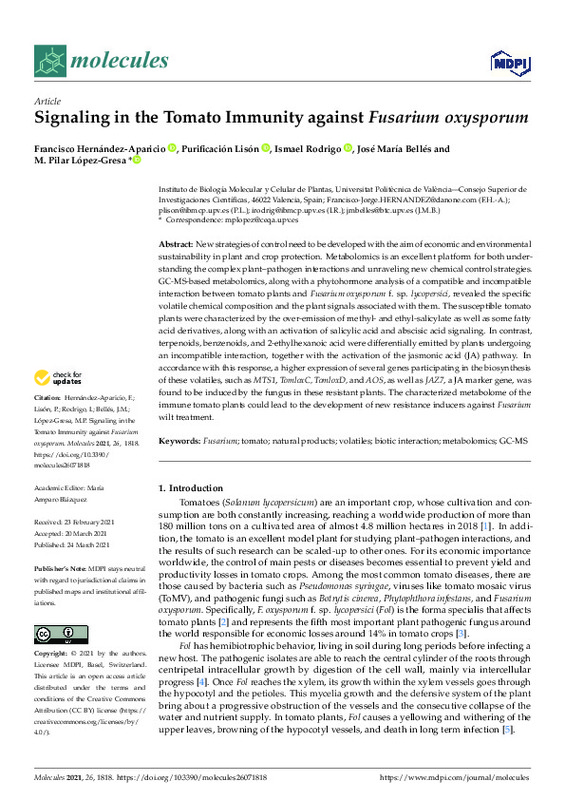JavaScript is disabled for your browser. Some features of this site may not work without it.
Buscar en RiuNet
Listar
Mi cuenta
Estadísticas
Ayuda RiuNet
Admin. UPV
Signaling in the tomato immunity against Fusarium oxysporum
Mostrar el registro sencillo del ítem
Ficheros en el ítem
| dc.contributor.author | Hernández-Aparicio, Francisco Jorge
|
es_ES |
| dc.contributor.author | Lisón, Purificación
|
es_ES |
| dc.contributor.author | Rodrigo Bravo, Ismael
|
es_ES |
| dc.contributor.author | Belles Albert, José Mª
|
es_ES |
| dc.contributor.author | López-Gresa, María Pilar
|
es_ES |
| dc.date.accessioned | 2022-02-09T19:04:50Z | |
| dc.date.available | 2022-02-09T19:04:50Z | |
| dc.date.issued | 2021-03-24 | es_ES |
| dc.identifier.uri | http://hdl.handle.net/10251/180673 | |
| dc.description.abstract | [EN] New strategies of control need to be developed with the aim of economic and environmental sustainability in plant and crop protection. Metabolomics is an excellent platform for both understanding the complex plant-pathogen interactions and unraveling new chemical control strategies. GC-MS-based metabolomics, along with a phytohormone analysis of a compatible and incompatible interaction between tomato plants and Fusarium oxysporum f. sp. lycopersici, revealed the specific volatile chemical composition and the plant signals associated with them. The susceptible tomato plants were characterized by the over-emission of methyl- and ethyl-salicylate as well as some fatty acid derivatives, along with an activation of salicylic acid and abscisic acid signaling. In contrast, terpenoids, benzenoids, and 2-ethylhexanoic acid were differentially emitted by plants undergoing an incompatible interaction, together with the activation of the jasmonic acid (JA) pathway. In accordance with this response, a higher expression of several genes participating in the biosynthesis of these volatiles, such as MTS1, TomloxC, TomloxD, and AOS, as well as JAZ7, a JA marker gene, was found to be induced by the fungus in these resistant plants. The characterized metabolome of the immune tomato plants could lead to the development of new resistance inducers against Fusarium wilt treatment. | es_ES |
| dc.language | Inglés | es_ES |
| dc.publisher | MDPI AG | es_ES |
| dc.relation.ispartof | Molecules | es_ES |
| dc.rights | Reconocimiento (by) | es_ES |
| dc.subject | Fusarium | es_ES |
| dc.subject | Tomato | es_ES |
| dc.subject | Natural products | es_ES |
| dc.subject | Volatiles | es_ES |
| dc.subject | Biotic interaction | es_ES |
| dc.subject | Metabolomics | es_ES |
| dc.subject | GC-MS | es_ES |
| dc.subject.classification | BIOQUIMICA Y BIOLOGIA MOLECULAR | es_ES |
| dc.title | Signaling in the tomato immunity against Fusarium oxysporum | es_ES |
| dc.type | Artículo | es_ES |
| dc.identifier.doi | 10.3390/molecules26071818 | es_ES |
| dc.rights.accessRights | Abierto | es_ES |
| dc.contributor.affiliation | Universitat Politècnica de València. Departamento de Biotecnología - Departament de Biotecnologia | es_ES |
| dc.description.bibliographicCitation | Hernández-Aparicio, FJ.; Lisón, P.; Rodrigo Bravo, I.; Belles Albert, JM.; López-Gresa, MP. (2021). Signaling in the tomato immunity against Fusarium oxysporum. Molecules. 26(7):1-17. https://doi.org/10.3390/molecules26071818 | es_ES |
| dc.description.accrualMethod | S | es_ES |
| dc.relation.publisherversion | https://doi.org/10.3390/molecules26071818 | es_ES |
| dc.description.upvformatpinicio | 1 | es_ES |
| dc.description.upvformatpfin | 17 | es_ES |
| dc.type.version | info:eu-repo/semantics/publishedVersion | es_ES |
| dc.description.volume | 26 | es_ES |
| dc.description.issue | 7 | es_ES |
| dc.identifier.eissn | 1420-3049 | es_ES |
| dc.identifier.pmid | 33804901 | es_ES |
| dc.identifier.pmcid | PMC8036676 | es_ES |
| dc.relation.pasarela | S\431340 | es_ES |
| upv.costeAPC | 1600 | es_ES |








